Heroic defense of Petropavlovsk
prehistory
No value, neither military-strategic, nor economic, the attack of the British on Solovki and Coke (The barbaric attack of the British on the Solovki monastery and the burning of Coke) did not have. It had only a propaganda effect. The “victory” over the “Russian port of Cola” was talked about in England with great pleasure and fervor. This hype was supposed to hide that the 1854 campaign of the year began for the Allies without much success (other than the capture of Beaumarzund). The news of the burning of Cola was a joyful reading for the London inhabitants and showed the power of the "Mistress of the seas."
More serious plans for the British were in the Pacific. The British Empire sought to achieve dominance in the Pacific. And for this it was necessary to strike a serious blow to the Russian Empire, which, owning the Russian Far East, Kamchatka and Alaska, could achieve complete domination in the northern part of the Asia-Pacific region. Unfortunately, West-centrism prevailed in Petersburg. The vast majority of the resources of the empire went to the European, including the Balkans, affairs. The eastern lands were mastered almost exclusively thanks to the asceticism and personal feat of a number of statesmen, researchers and industrialists. Tens of years of peace have not been used to create an industrial base in the Far East and to build up military potential, able to keep the already attached lands behind Russia and to reinforce by force the possible expansion of the empire into new lands. In particular, Russia had every opportunity to join the Hawaiian Islands, the new lands in America, to create a protectorate in Korea, etc., but did not use them.
Therefore, the Eastern War has become a serious challenge for Russia, and there is a real threat of losing territories in the east of the empire. The British did not accept the fact that for a long time a significant part of the northern Pacific coast belonged to the Russian Empire. Britain's desire to undermine Russia's position in the Pacific in the middle of the 19th century was especially strong. Easily defeating the Chinese empire in the First Opium War of the 1840 — 1842, the British believed that now was the time to “put in place” and Russia in order to achieve complete supremacy of the British Empire in the Asia-Pacific region.
Since the 1840-s, the most far-sighted leaders of Russia began to worry about the future of the Russian Pacific possessions. Especially feared for Kamchatka. It was suspicious that since the middle of the 1840-s foreign whalers have come to the port often, they behaved disgustingly, as masters, began to commit various atrocities. English ships began to arrive in Petropavlovsk, often under a foreign flag. It was obvious that the enemy was scouting.
In 1848, Count Nikolai Nikolayevich Muravyov, who became General-Governor of Eastern Siberia since 1847, drew attention to the growing threat of attack by foreigners, primarily British, on Kamchatka and the Amur region. I must say that Nikolai Muravyov (Muravyov-Amursky) played a prominent role in stories Russian Far East, joining the mouth of the Amur to Russia. With his support, new Russian settlements were founded, and at the beginning of 1854, he obtained from Emperor Nicholas I permission to make troops rafting on the Amur River. In May 1854, the first rafting of the troops took place, a year later - the second, with the soldiers arrived at the mouth of the Amur, the first Russian settlers. Russian presence in the Far East was significantly strengthened.
In addition, in 1848, Muravyov decided to start building military fortifications in Petropavlovsk. In the summer of 1849, Muraviev arrived at the port of Petropavlovsk in transport “Irtysh”. The Governor-General examined the area and outlined the construction sites for new batteries. So, Muravyov proposed to build batteries on Signal Cape, on the Peter and Paul Spit, and at Lake Kultushny. N. N. Muravyov, in a letter to the Minister of Internal Affairs, L. A. Perovsky, warned that the Avacha Bay should be strengthened, since without this it could be captured by the most insignificant enemy squadron. The place was very convenient, and it was obvious that during the war the enemy would try to capture it.
Russian marine painter Alexei Petrovich Bogolyubov. Defense of the Petropavlovsk Port 24 August 1854 of the year
Vasily Zavoiko
It was then that the governor of Eastern Siberia appointed the new ruler of Kamchatka. They became an energetic administrator, Major General Admiralty Vasily Stepanovich Zavoyko. The future hero of the Peter and Paul Defense came from the nobles of the Poltava province. His father Stepan Osipovich Zavoyko was retired naval a doctor, the head physician of the Nikolaev Maritime Hospital. Mother nee Euphemia Fesun came from a Cossack family. The family was not rich and owned a small farm.
Vasily studied at the Makaryevsky monastic seminary, then at the Black Sea navigator school in Nikolaev. He began his service in 1821 in the brig "Mingrelia". He served on the Black Sea Fleet. At the beginning of 1827, he was promoted to midshipmen (first officer rank) and transferred to the Baltic Fleet. On the ship "Alexander Nevsky" participated in the Battle of Navarino, in this battle, the young man commanded four guns in the bottom deck and was head of the first corporal of the first boarding squad. The Russian frigate led the battle simultaneously with three enemy ships, one sank, the other captured. For distinction in battle and personal bravery was awarded the Order of St.. Anna 3 degree.
Then Vasily served on the corvette Navarin, in which, as part of the Heyden squadron, he took part in the blockade of the Dardanelles. After returning to the Baltic, he served on the same corvette and brig "Hektor". In 1833, he was promoted to lieutenant, served on the frigate "Pallada" under the command of P. S. Nakhimov. In 1834 − 1836 traveled around the world from Kronstadt to Kamchatka and back by Amur. In 1837 − 1839 on the ship of the Russian-American Company (Cancer) "Nikolay" made a world tour from Kronstadt to Russian America. From 1840, he served in the CANCER and was chief of the Okhotsk trading post. In 1842 − 1844 Zavoyko surveyed the entire east coast of the Sea of Okhotsk and the Shangara Islands and decided to arrange the Ayan Factoring Bay as the port of Okhotsk was less convenient. In January, 1844, “for success for the good of the Fatherland,” Zavoyko received the rank of lieutenant commander. For the establishment of Ayan port was awarded the Order of St.. Anna 2-th degree, and in 1846, Vasily Stepanovich was promoted to captain of 2 rank. He became the head of the new port.
In November, Muravyov prepared a presentation on Zavoyko. In February, 1850, he was appointed the correcting post of the Kamchatka military governor and commander of the port of Petropavlovsk in Kamchatka. Zavoyko organized the construction of the schooner "Anadyr", bots "Aleut" and "Kamchadal." In the summer of 1853, Zavoyko received the rank of major general and was approved as governor of Kamchatka.
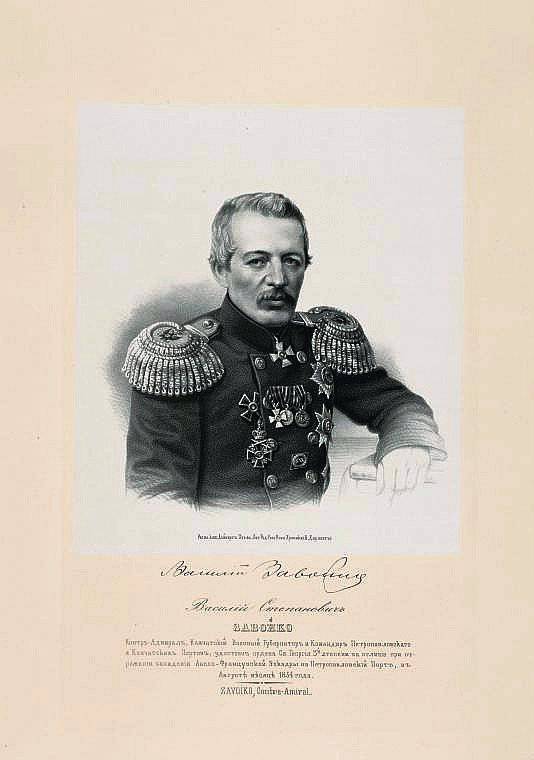
Vasily Stepanovich Zavoyko (1809 − 1898)
Preparing the defense of Petropavlovsk
In March, 1854, Zawoyko received a letter from the King of Hawaii, Kamehamea III, who was friendly to Russia and informed the British and French of a possible attack on Petropavlovsk in the summer. In his horse, official news of the beginning of the war was received from the Russian Consul General to the United States. Zavoyko immediately appealed to the entire population of Kamchatka and warned people about a possible attack by the enemy. The port of Petropavlovsk must be prepared for the defense, and its inhabitants are ready “not to spare lives, to resist the enemy and cause him any possible harm”. Women and children needed to be taken to a safe place. Zavoiko noted: “I am in firm determination, no matter how numerous the enemy was, to do to protect the port and the honor of the Russian weapons all that is possible in human power, and fight to the last drop of blood; I am convinced that the flag of the port of Petropavlovsk will in any case be a witness to feats of honor and Russian valor! ”
Zavoiko had extremely weak means of defense: the garrison comprised just 231 people, and the artillery armament consisted of six 6-pounders and one field 3-pound cannon mounted on a horse. However, he was able to use the enemy's mistake - the Allied command was confident of success and did not rush to Petropavlovsk. The Major General managed to complete most of the work to create the main fortifications of the port of Peter and Paul before the arrival of the allied squadron. The batteries were built in the hope of getting the guns requested from the command. In addition, volunteers formed rifle and fire brigades.
Fortunately for the defenders of Petropavlovsk, in July, 1854 came unexpected help. 1 July 1854 of the year, completing the semicircular voyage, entered the 58-gun frigate Aurora (at various times it was armed with 44, 54, 56 and 58 guns) under the command of Lieutenant Commander Ivan Nikolaevich Izylmetyev. Aurora 21 August 1853 left Kronstadt to the Far East, and moved along the route Copenhagen - Christiansand - Portsmouth - Rio de Janeiro - Cape Horn - Callao - De Kastri Bay. The frigate went to strengthen the Pacific squadron under the command of Vice-Admiral E. V. Putiatin. But, due to the lack of fresh water and scurvy of the crew that hit the 2 / 3 (there was practically no healthy person on the ship), Izylmetiev decided to make a stop in Petropavlovsk. Having received a status report, the captain-lieutenant agreed to Zavoyko’s request to remain in Petropavlovsk and help repel the attack of the Anglo-French squadron.
I must say that the Aurora was almost intercepted by the enemy. The hike was hard. For nearly twenty days, head-on storm winds prevented the ship from entering the Pacific Ocean. A lot of people ached: 8 sailors died, 35 was in serious condition. The ship needed urgent repairs: the deck grooves flowed, the rigging weakened, and the supplies were running out. Only 13 March frigate passed the ship graveyard ”- Cape Horn. The ship made a stop in the Peruvian port of Callao. Here the Russian ship was surrounded by the Anglo-French squadron. In the bay were the British frigates President and Pike under the flag of Rear Admiral David Price, the French frigates Fort and Eurydice under the flag of Rear Admiral Febrier de Pointe, the French brig Obligado. The news of the beginning of the war has not yet been received, but it was expected. Russian frigate fell into the trap.
Externally, the situation was as usual. Russian captain-lieutenant Izylmetev and both admirals exchanged the usual peacetime visits of politeness. Izylmetyev, trying not to show it, accelerated repair work. 14 (26) April 1854, the Russian frigate was able to escape from the trap. Using a dense fog, seven desyewing boats were launched from the Aurora. The ship raised anchor, the sails were not raised and the boats towed the Aurora into the open sea. They set sail and disappeared into the ocean before foreigners could organize a chase. A week later came the news of the beginning of the war.
The hike to Petropavlovsk was very difficult. The ship fell into a band of cruel winds with continuous squalls, "Aurora" gained a lot of water. Diseases hit almost the entire crew. Died 13 people. Isylmetyev himself also fell ill, he transferred command to lieutenant commander Mikhail Petrovich Tirol. After the arrival of the frigate in Petropavlovsk, they were brought ashore and sent 196 people to Paratunka village for treatment with hot keys (19 could not be saved).
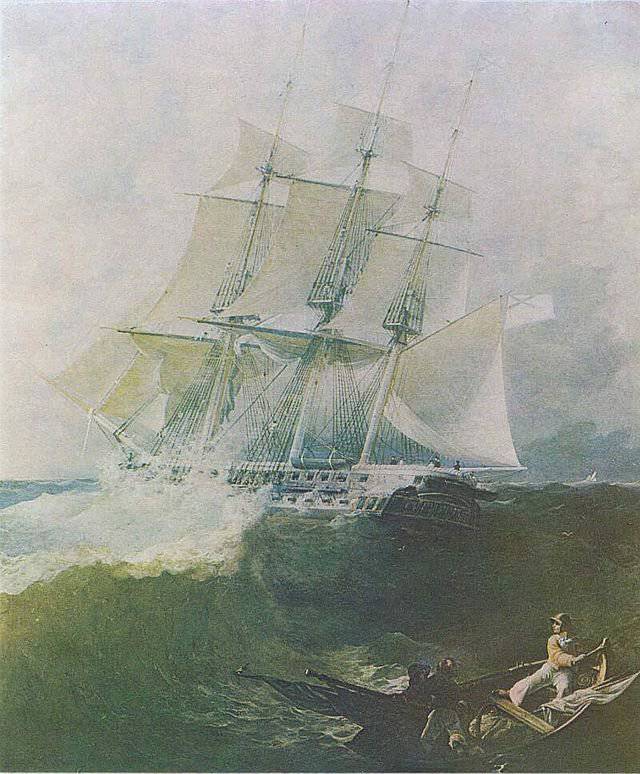
The painter P. T. Boryspolec. Frigate "Aurora" during a storm
The arrival of the Aurora strongly strengthened the defense of Petropavlovsk: part of the crew was transferred to the coast as a reserve of the garrison, the right side guns were removed and transferred to the coastal batteries, strengthening the artillery defense system. In addition, 24 July (5 August) 1854, the military arrived (brigantine) "Dvina". He delivered 350 soldiers to the Siberian Linear Battalion under the command of Captain A. P. Arbuzov (he was appointed Assistant Kamchatka Military Governor VS Zavoyko), 2 bombardment double-throw caliber and 14 cannon 36-pound caliber. A military engineer, Lieutenant Konstantin Mrovinsky, who led the construction of coastal fortifications, arrived at Dvina. As a result, by the end of July, the garrison of Petropavlovsk was composed according to the report of Zavoyko 988 people (349 people on ships, 368 on artillery batteries and 271 people in rifle batches). With a few dozen volunteer shooters, the garrison was more than 1 thousand people.
Soon after the arrival of the Dvina, all the teams gathered on the square. They were informed about the declaration of war, then the order of the governor. Zavoiko himself asked everyone to “fight to the last extreme, but if the enemy force will be overwhelming, then die without thinking of retreat. Everyone expressed their willingness to die rather than retreat. ”
Day and night, almost two months (taking advantage of the enemy's slowness), the defenders of Petropavlovsk erected fortifications. Work was underway on the construction of seven shore batteries and the installation of guns. In the rocks, the sites for guns were cut down, inaccessible to the enemy, transported guns from ships, installed them. Almost the entire population of the city and its environs participated (about 1600 people). From the frigate "Aurora" and military transport "Dvina removed the guns of the right sides, reinforcing the coastal batteries. The ships anchored the left sides of the harbor exit in order to meet with fire a possible breakthrough of the enemy. The entrance to the harbor was closed with a boom. To repel the enemy assault three rifle detachment.
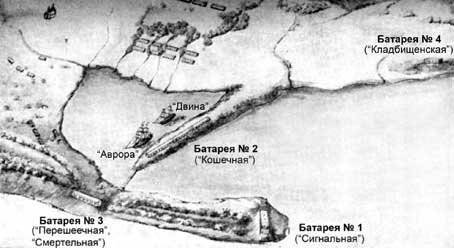
Artillery batteries covered the port of Petropavlovsk horseshoe. At its right end, in the cliffs of Cape Signal, was the battery No. 1. The “signal” battery was the entrance to the internal raid and was armed with three 36-pounders, two bombing cannons, its garrison was 64 man. Also on the right side, on the isthmus between the Signal Hill and Nikolskaya Hill, another battery was placed. A "pedestrian" battery (No. 3) was armed with five 24-pounders, its garrison was 51 people. At the northern end of Nikolskaya Sopka, on the very shore, they put the battery number 7. It was designed to prevent the landing of enemy troops to the rear and attempts to seize the port from the north. The battery was armed with five 24-pounders, protected by 49 people. Another battery was located on the crook of an imaginary horseshoe, at Kultushnoye Lake. The “lake” battery (No. 6) was armed with six 6-pounders, four 18-pounders, its garrison was 34 people. The “lake” battery reinforced the defenses of battery No. 7 and had to keep under defile and the road between Nikolskaya Sopka and Kultushny lake. Then came the "Port" and "Cemetery" batteries (batteries No. 5 and No. 4). Battery No.5 was armed with five practically unusable 3-pounders for combat. Battery No.4 was armed with three 24-pounders and had a garrison in 24 man. On the sand spit Cat was the main battery number 2. The "cat" battery was armed with nine 36-pounders, one 24-pound cannon, its garrison was 127 people.
Forces of the enemy
7 May Rear Admirals David Price and Febriet de Pointe received news of the start of the war. Only 17 in May, two frigates (one English, another French), accompanied by two steamboats, sailed into the Pacific Ocean, in a faint hope of finding the Aurora. It is clear that they did not overtake the Russian frigate. First they stood at the Marquesas Islands, and then went to the Sandwich Islands, where they learned that 18 days ago there was another Russian ship, the Dvina. And here the allies were slow, only 25 July left the Sandwich Islands and moved to Kamchatka.
In the evening of August 16 (28) from distant lighthouses Zavoyko reported that a squadron appeared on the horizon. The composition of the Allied squadron included: British 52-gun frigate "President", 44-gun frigate "Pike", the ship "Virago" armed with 6 bomb weapons; French 60-gun frigate "Fort", 32-gun frigate "Evridika", 18-gun brig "Obligado." The squadron personnel consisted of 2,7 thousand people (2,2 thousand people - the crews of ships, 500 people - marines).
The allied squadron approached its destination under adverse weather conditions and very slowly. The steamboat Virago, which covered up the flag of the United States and went to Avacha Bay, was sent for reconnaissance. The Russians very soon noticed the steamer "Virago" and sent the bot. The commander of the ship did not wait for him, hastily dispersed the pair and left. It became finally clear that the enemy had come.
The steamer commander reported to Admiral Price that he had seen several ships and coastal batteries in the bay (they found three batteries). He also noted that the entrance to the narrow strait, which connects the ocean with the bay, is not protected by anything, although the Russians are trying to strengthen it. The city of Petropavlovsk itself was located on the eastern side of the large Avacha Bay, deep in the mouth, which was connected to the Avacha Bay "throat". This lip and defended "Aurora" and "Dvina".
This was the first information the Allies received about Petropavlovsk. It became obvious that there was no sudden strike, which seriously complicated the position of the Anglo-French squadron, which was not able to fight a serious defense. Thus, the British ships were mainly armed with short-barreled guns, little adapted to combat the enemy’s fortifications.
Steamer "Virago"
To be continued ...
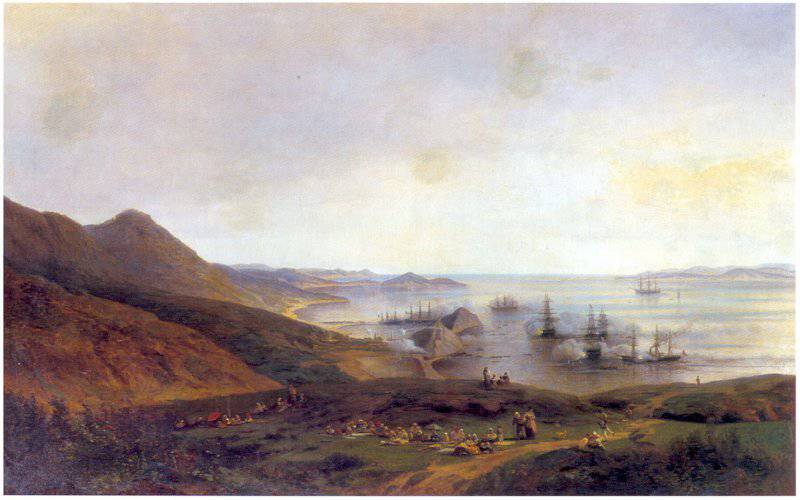
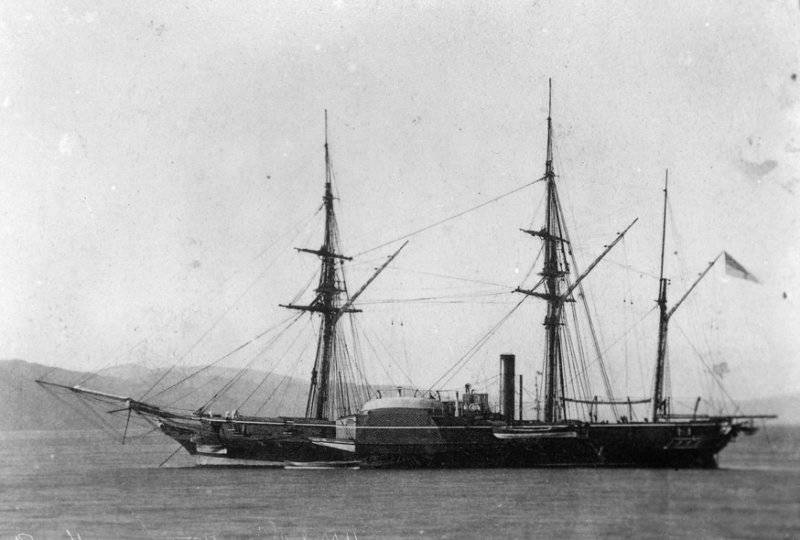
Information